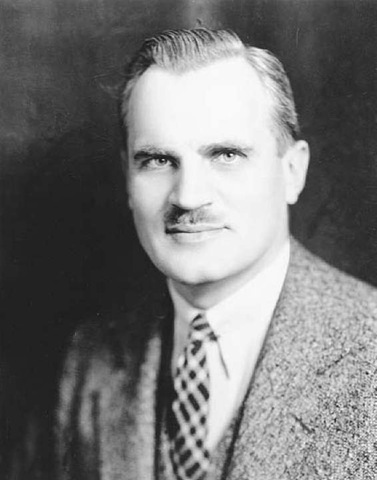(1892-1962) American Experimentalist (Electromagnetism), Particle Physicist
Arthur Holly Compton won the 1927 Nobel Prize in physics for his discovery of what came to be known as the Compton effect, a quantum mechanical explanation of the phenomenon in which high-energy electromagnetic waves such as X rays undergo an increase in wavelength after being scattered by electrons. This work, which was recognized as experimental proof that electromagnetic radiation is quantized, possessing both classical wavelike properties and particlelike photon properties, was a foundation of the new field of quantum electrodynamics. As a member of the Manhattan Project, Compton also played a major role in the development of the atomic bomb.
He was born on September 10, 1892, in Wooster, Ohio, into an educated, pious family. His father was a Presbyterian minister and professor of philosophy at the College of Wooster, his mother a Mennonite, dedicated to missionary causes, who had been the 1939 Mother of the Year. While choosing a science career, like his older brother, Karl, Arthur maintained the family tradition of religious dedication. He attended the College of Wooster, where he earned a bachelor’s degree in 1913. He then went on to Princeton University for postgraduate study, earning a master’s degree in 1914 and a Ph.D. in 1916. Here he devised an elegant method for demonstrating the Earth’s rotation. In 1 91 6, he married Betty Charity McCloskey, with whom he would have two sons. Then he spent a year as an instructor of physics at the University of Minnesota. His next position was as a research engineer with the Westinghouse Lamp Company in Pittsburgh. In 1919, he left for Cambridge University, England, as a National Research Council Fellow; there he worked with ernest rutherford at the Cavendish Laboratory on the properties of scattered gamma rays.
In these experiments he discovered that scattering X rays on a graphite block lowered their energy, thereby increasing their wavelength. This phenomenon was clearly unlike the scattering of classical waves, in which the wavelength remains the same when it bounces off a surface. Since the groundbreaking work of james clerk maxwell, the classical wave nature of electromagnetic radiation had been firmly established. Then, in 1905, albert einstein announced his theory of the photoelectric effect: that light is simultaneously a wave and a particle he called a photon. In this context Compton conjectured that the X rays must be acting as light particles or photons, that is, transferring their energy to the graphite electrons with which they collide. Theoretically, Compton treated the X-ray scattering as being due to a collision between a quantum of the electromagnetic field (i.e., a photon) and an electron, the latter regarded as a free particle initially at rest. Then, conservation of energy and momentum required the photon to transfer energy and momentum to the electron, causing the wavelength of the photon to increase. Compton’s discovery confirmed the particle nature of the photon and placed the quantum prediction of wave-particle duality on a firm experimental foundation. In the same set of experiments he also discovered the phenomenon of complete reflection of X rays and their total polarization, which led to a more accurate determination of the number of electrons in an atom.
In 1923, he moved to the University of Chicago as professor of physics, and four years later he shared the 1927 Nobel Prize with charles thomsom rees wilson, the discoverer of the cloud chamber.
In the 1930s, the emphasis of his research shifted to cosmic rays, whose nature physicists were then debating: are they a form of electromagnetic radiation that passes in undeflected straight lines from outer space through the Earth’s magnetic field, as robert andrews mil-likan suggested? Or are they streams of charged particles, which would, therefore, be deflected along curved paths as they traversed the Earth’s magnetic field, as the German physicist Walther Bothe believed? To attempt to settle the question, Compton carried out measurements at thousands of locations around the world and found conclusive evidence that cosmic rays must consist of charged particles.
In 1941, finding himself unable to embrace the pacifism of his mother’s Mennonite creed, he agreed to serve as chairman of the National Academy of Sciences Committee to Evaluate Use of Atomic Energy in War, organized at the University of Chicago, which included enrico fermi, Leo Szilard, and eugene paul wigner. Compton designed methods of isolating fissionable plutonium and, with Fermi, produced a self-sustaining nuclear chain reaction, which led to the development of the atomic bomb. He also played a role in the government’s decision to use the bomb. He was responsible for the appointment of j. robert oppenheimer to head the atomic bomb project, and afterward he defended Oppenheimer’s loyalty to the United States, when, during the postwar McCarthy era, he was investigated by the House Un-American Activities Committee.
In 1945, at the war’s conclusion, Compton returned to Saint Louis as chancellor, a position he held until 1954, when he became professor of natural philosophy. He retired in 1961, when he became Distinguished Service Professor of Natural Philosophy at Washington University. He died on March 15, 1962, in Berkeley, California.
A prolific writer, he wrote several books on social and moral issues, including The Freedom of Man (1935), The Human Meaning of Science (1940), and Atomic Quest—a Personal Narrative (1956), in addition to his numerous technical publications.
Discovery of the Compton effect played an important role in the development of quantum electrodynamics, in which the electromagnetic field itself behaves according to the rules of quantum mechanics. The orbiting Compton Gamma Ray Observatory, named in his honor, was launched on April 5, 1991, and returned to Earth on June 5, 2000. It conducted experiments that relied on the intricate understanding of the interaction of matter and high-energy gamma rays that Compton discovered in his groundbreaking experiments.
Arthur Holly Compton discovered the Compton effect, a quantum mechanical effect in which high-energy X rays increase in wavelength after scattering by electrons.

